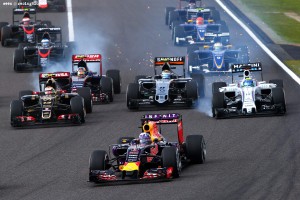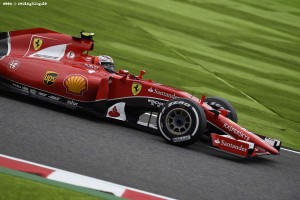The Japanese Grand Prix saw normal service resumed with Mercedes taking a 1-2 finish that puts the team in touching distance of a second constructors’ title, but it also hinged on some big strategy calls and illustrated how pivotal the start is to the way a race unfolds.
 Sebastian Vettel felt that second place ahead of Nico Rosberg was on the cards; a result that would have been symbolic given that their battle for second in the championship. But how did the result get away from Ferrari? Meanwhile we saw some great work by Nico Hulkenberg and Force India to get a sixth place result from 13th on the grid.
Sebastian Vettel felt that second place ahead of Nico Rosberg was on the cards; a result that would have been symbolic given that their battle for second in the championship. But how did the result get away from Ferrari? Meanwhile we saw some great work by Nico Hulkenberg and Force India to get a sixth place result from 13th on the grid.
Rain throughout Friday practice meant that the teams had very little data on the tyre performance on long runs. Added to that, Pirelli had mandated high tyre pressures, which could lead to tyre overheating and this created a sense on the unknown going into the Grand Prix. Who would it favour? Crucially two pieces of information were there from Saturday, which dictated the main talking point on Sunday. First Mercedes was very quick in Q1 on the hard tyres on a single lap and second Ferrari didn’t have a great deal of long run data from Saturday morning’s FP3 session. Both would prove crucial to the outcome.
Ferrari vs Mercedes
After pole sitter Nico Rosberg lost the start to team mate Lewis Hamilton, his chance of victory was gone. It was a huge blow as it means that Hamilton can now afford not to win another race this season and he will still be champion, even if he follows Rosberg home for the last five races.
The key battle was all about how Rosberg recovered to second after dropping to fourth and this was achieved with race strategy. The battle with Vettel is the one to really focus on, as it was decided by an incredibly fine margin and afterwards there was a feeling around Ferrari that they could have held onto second place. So why didn’t they? Vettel drove a very clever middle stint, managing the tyres at the same time as maintaining the gap at two seconds, the margin by which they felt they would be safe from the undercut from Rosberg.
 This two second figure is a calculation, based on the expected pace of the Mercedes on an out lap and the expected time for Rosberg’s stop, set against what they expected Vettel to be able to do. Of course, the best way to avoid an undercut is to pit first. But the risk there is that you pit too early and run out of tyre performance in the closing laps.
This two second figure is a calculation, based on the expected pace of the Mercedes on an out lap and the expected time for Rosberg’s stop, set against what they expected Vettel to be able to do. Of course, the best way to avoid an undercut is to pit first. But the risk there is that you pit too early and run out of tyre performance in the closing laps.
As the laps ticked by, Vettel and Ferrari were waiting to get to the point at which they could safely fit a set of medium tyres and get to the finish. The Ferrari is better on the medium tyres than the hards.
First they had to deal with their other car and set up an undercut for Kimi Raikkonen on Valtteri Bottas which worked a treat. The older Finn pitted on Lap 28 and Bottas reacted and came in a lap later, losing fourth place to Raikkonen. Job done for Ferrari.
Mercedes took the opportunity when Bottas was in and Ferrari was looking at Bottas’ stop, to pit Rosberg. It wasn’t Mercedes’ best stop, but what followed shocked Vettel and Ferrari. Rosberg’s out lap on hard tyres was incredibly fast; 1m 55.869s. To put it into context, it was two seconds faster than the out lap Raikkonen had just pulled to undercut Bottas.
(Anmerkung: Kommt uns auch etwas … abgeschnitten vor, der Text, aber das ist die Version, die uns James geschickt hat. )

